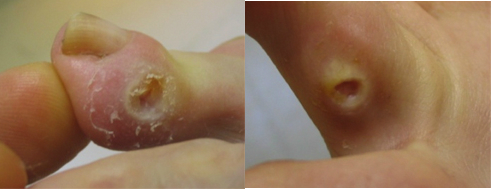What is a corn?
“Corn” is also known as “heloma” in a medical term which describes thick areas of skin that develop as a result of an excessive amount of pressure and friction being applied to the skin. Corns, rather than being a defect, are our body’s protective mechanism from further damage. There are types of corn that develop; hard corns known as heloma durum and soft corns known as heloma molle.
What causes painful corns?
Corns can be caused by a number of reasons:
- Enlarged joint
- Wearing tight/pointed shoes
- Adductovarus deformity of the toe: a crooked toe that moves under the adjacent toe

Conservative Treatments
Non-operational treatments: aims to reduce excessive pressure.
- Regular podiatry visit: Podiatrists can reduce the painful corn by debridement and manufacture custom-made toe separator to reduce excessive pressure.
- Avoid wearing tight/pointed shoes
- Do not use a corn pad as it contains salicylic-acids and when applied improperly, these corn pads can create a chemical burn in healthy tissue that may result in infections and ulcers.
Surgical Treatment
Surgery aims to remove enlarge joint (arthroplasty) and surgery is relatively simple with a small incision over the toe.
Do I need surgery?
Whether you have surgery or not is purely your choice. Surgery is usually recommended if conservative treatments have failed to provide good relief.
What does the surgery involve?
Surgery for painful interditial corn is a relatively quick and easy surgery. It usually involves:
- A small incision(around 2 cm) over the toe
- Removal of the condyle (head part of phalanx)
- Repair of tendon, capsule and skin closure
- If there is a tight tendon or contracted skin, tenotomy or lengthening of tendon or skin plasty are performed to address these problems
- Anaesthetics: Various anaesthetics are available (General or spinal block or local anaesthetics with sedation)
After the surgery
- Keep your foot elevated as much as possible and apply an ice pack for the first week following surgery
- Your dressing will be changed between 3-7 days at the office after surgery
- Keep your dressing dry for the first 2 weeks after surgery
- Sutures will be removed between 2-3 weeks after surgery
- You are able to weight-bear on the heel in the postop surgical shoe
- You need expect to wear postop surgical shoes for 1-2 weeks


